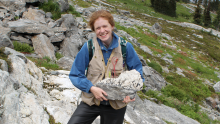UBC researchers have outfitted two BC subspecies of Swainson's thrushes with penny-sized, state-of-the-art geolocators in order to map their wildly divergent migration routes and pinpoint conservation hotspots.
"Birds of a feather do not necessarily flock together," says Kira Delmore, a PhD student with the Department of Zoology and lead author on the paper. "Our teams of thrushes took dramatically different routes to get to their wintering grounds, either south along the west coast to Central America, or southeast to Alabama and across the Gulf of Mexico to Columbia."
The study, to be published this week in the Proceedings of the Royal Society of London B, is the first to collect a complete year's worth of data from individual birds to document such a migratory divide.
"This detailed level of migration and stopover data helps us pinpoint vital feeding and rest habitats that the birds rely on at key points during their long journey – for example before crossing the Gulf of Mexico."
UBC researchers caught 40 thrushes in June 2010 – one subspecies from Pacific Spirit Park and another subspecies from locations near Kamloops. The birds were lured into six-metre-wide mist nets with mating calls. Researchers then attached the newly invented geolocation devices – which record sunrise and sunset times – on the birds with harnesses and released them. To collect the data, Delmore undertook the process in reverse a year later.
The details on route and stopovers from the two subspecies may also be valuable from an ecological and evolutionary standpoint. The two species interbreed in a narrow hybrid zone located to the northeast of Vancouver, and the different routes suggest that the two forms have different evolutionary histories and ecological requirements during migration and in their wintering habitats.
The study raises the possibility that migratory behavior may play a role in speciation, the process by which one species evolves into two.
"Given that migratory behavior is under genetic influence in many species of birds, these results raise the question of what hybrids between these two subspecies would do," says Darren Irwin, associate professor of Zoology at UBC and coauthor of the paper. "A possibility is that hybrids would take an intermediate route, leading to more difficulties during migration. If so, the migratory differences might be preventing the two forms from blending into one."
Swainson's thrushes – with olive-brown feathers, lighter mottled undersides, and distinct light eye-rings – are typically 16 to 20 centimetres (7 inches) in length with a wingspan of 30 cm (1 foot). They are not endangered. The geolocators used weigh 0.9g, with attachment materials they weight approximately 4 per cent of the body weight of a thrush.
This research was funded by Natural Sciences and Engineering Research Council of Canada, Environment Canada, and the Wilson Ornithological Society.
Musqueam First Nation land acknowledegement
We honour xwməθkwəy̓ əm (Musqueam) on whose ancestral, unceded territory UBC Vancouver is situated. UBC Science is committed to building meaningful relationships with Indigenous peoples so we can advance Reconciliation and ensure traditional ways of knowing enrich our teaching and research.
Learn more: Musqueam First Nation
Faculty of Science
Office of the Dean, Earth Sciences Building2178–2207 Main Mall
Vancouver, BC Canada
V6T 1Z4


